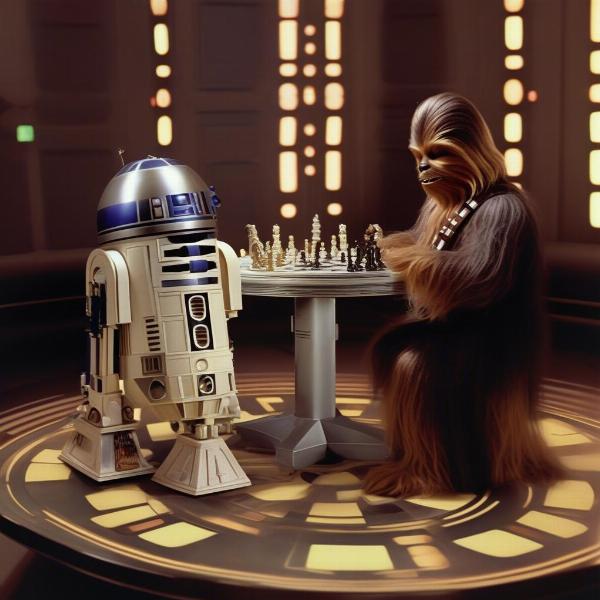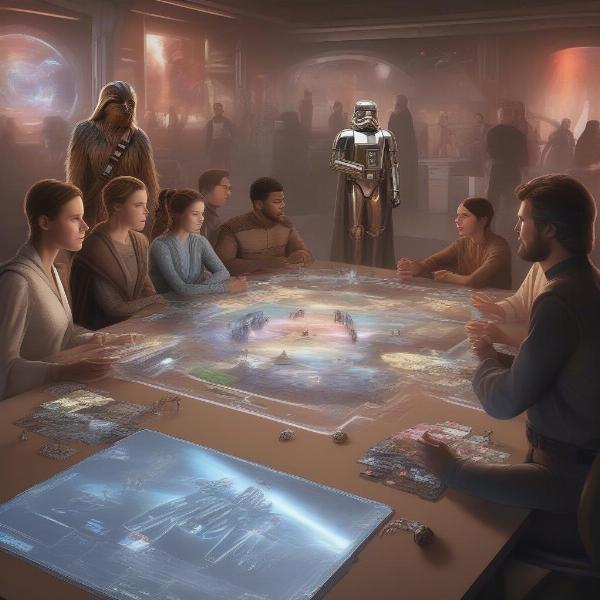The galaxy far, far away has always captivated us with its incredible technology. From lightsabers to hyperspace travel, Star Wars has fueled our imagination and inspired real-world innovation. At supremeduelist.blog, we explore how elements of the Star Wars universe are becoming reality, and today, we’re diving deep into the fascinating world of Hologram Game Star Wars, an immersive entertainment experience that’s closer than you think.
This article will explore the evolution of holographic technology, its application within the Star Wars universe, and the potential for real-world hologram games inspired by this iconic franchise. We will also examine the technical challenges and future possibilities of bringing the thrill of Star Wars battles to life through interactive holograms.
What is a Hologram Game Star Wars Style?
A hologram game, particularly one in the Star Wars style, refers to an interactive entertainment experience that utilizes holographic projections to create a three-dimensional, seemingly tangible environment for players. Think of it as bringing the Dejarik holochess game from Star Wars: A New Hope to life, but with more advanced technology and interactive gameplay.
In the Star Wars universe, holograms are commonly used for communication, data display, and even training simulations. The concept extends beyond simple projections to involve responsive, interactive elements that players can manipulate and engage with. In a real-world context, achieving this level of interaction requires sophisticated technology, including:
- Advanced projection systems
- Motion tracking technology
- Real-time rendering engines
- Haptic feedback devices
The goal is to create a seamless blend of the digital and physical worlds, offering a level of immersion that traditional video games simply can’t match.
The Evolution of Holographic Technology and Its Star Wars Influence
The idea of holographic technology has been around for decades, but only recently has it started to become a tangible reality. Early holograms were static images, but advancements in laser technology, computer processing power, and materials science have paved the way for dynamic, interactive holographic displays.
Star Wars has undoubtedly played a role in driving interest and innovation in this field. The film series presented a vision of holographic communication and entertainment that captured the imagination of scientists and engineers. While real-world technology hasn’t quite reached the level of sophistication seen in the movies, significant progress has been made:
- Static Holograms: Used for security and displays.
- Pepper’s Ghost Illusion: A technique used in concerts to create the illusion of a performing artist.
- Volumetric Displays: Project 3D images into a volume of space.
- Light Field Displays: Recreate the way light interacts with objects to create realistic 3D images.
These advancements are slowly but surely bringing the dream of a Star Wars-style hologram game Star Wars closer to realization.
 Star Wars Hologram Chess Game
Star Wars Hologram Chess Game
From Dejarik to Interactive Battles: Star Wars Hologram Games
The holochess game, Dejarik, introduced in Star Wars: A New Hope, is arguably the most iconic example of hologram game Star Wars. It showcased a game where creatures battled on a holographic board, combining strategy and visual spectacle. This concept has fueled the desire to create more advanced and immersive hologram games.
Imagine a hologram game Star Wars where you could command your own squadron of X-wings against Imperial TIE fighters, with the battle unfolding in a three-dimensional space right in front of you. Or perhaps a lightsaber duel against Darth Vader, where you could physically block his attacks and feel the impact through haptic feedback technology.
These scenarios highlight the potential for immersive and engaging gameplay that holographic technology could offer, bringing the excitement of Star Wars battles to life in a whole new way.
“The allure of hologram games lies in their ability to transport players into another world,” says Dr. Aris Thorne, a lead developer in augmented reality. “Star Wars, with its rich universe and iconic battles, is the perfect setting for this type of immersive experience. It’s about making the impossible possible and creating something that truly blurs the line between reality and fantasy.”
Technical Challenges in Creating a Real-World Hologram Game Star Wars
While the vision of a hologram game Star Wars is enticing, significant technical challenges must be overcome to make it a reality. These challenges include:
- Creating High-Resolution, Stable Holograms: Holograms need to be clear, stable, and viewable from multiple angles without distortion.
- Developing Accurate Motion Tracking: The system needs to accurately track the player’s movements and translate them into in-game actions.
- Implementing Haptic Feedback: Providing realistic tactile sensations to enhance immersion.
- Reducing Latency: Minimizing the delay between the player’s actions and the game’s response to prevent motion sickness and frustration.
- Cost and Scalability: Making the technology affordable and accessible to a wider audience.
Overcoming these challenges requires ongoing research and development in various fields, including optics, computer science, and engineering.
Addressing Latency and Motion Tracking for Seamless Immersion
Latency, the delay between input and response, is a critical factor in creating a believable and enjoyable hologram game experience. High latency can lead to motion sickness and disrupt the sense of immersion. Advanced motion tracking technology is also crucial. Here are some solutions being explored:
- Predictive Algorithms: Anticipating the player’s movements to reduce the perceived latency.
- High-Speed Sensors: Using sensors that can track movements with greater accuracy and speed.
- Optimized Rendering Engines: Developing rendering engines that can quickly process and display holographic images.
- Wireless Technology: Implementing robust wireless technology to minimize cable constraints and improve movement freedom.
These improvements are essential to creating a seamless and responsive hologram game Star Wars that feels natural and immersive.
 Star Wars Hologram Tabletop Game Concept
Star Wars Hologram Tabletop Game Concept
Potential Applications and the Future of Hologram Game Star Wars
Beyond entertainment, hologram game Star Wars technology has a wide range of potential applications. These include:
- Education and Training: Creating immersive learning experiences for students and professionals.
- Military Simulations: Providing realistic training scenarios for soldiers.
- Medical Visualization: Allowing doctors to visualize and manipulate 3D models of organs and tissues.
- Product Design: Enabling designers to create and interact with virtual prototypes.
The future of hologram game Star Wars and holographic technology in general is bright. As technology continues to advance, we can expect to see more sophisticated and immersive experiences that blur the line between the digital and physical worlds.
Voice Control and AI Integration: Enhancing Interactivity
The integration of voice control and artificial intelligence (AI) can further enhance the interactivity and realism of hologram game Star Wars. Imagine being able to command your troops with your voice, or having an AI opponent that adapts to your strategies in real-time.
- Voice Commands: Allowing players to control characters, issue commands, and interact with the environment using their voice.
- AI-Driven Opponents: Creating intelligent opponents that can learn and adapt to the player’s strategies, providing a challenging and engaging experience.
- Personalized Experiences: Using AI to tailor the game to the player’s skill level and preferences.
These advancements will contribute to a more immersive and personalized gaming experience, bringing the fantasy of hologram game Star Wars closer to reality.
“The future of gaming is not just about better graphics, but about creating more immersive and interactive experiences,” says Elara Venter, a gaming experience designer. “Holographic technology, coupled with AI and voice control, has the potential to revolutionize the way we play games. It’s about creating worlds that feel alive and responsive to our actions.”
Conclusion: The Dawn of Immersive Hologram Gaming
The concept of a hologram game Star Wars is no longer a distant dream. Advancements in holographic technology, motion tracking, and haptic feedback are paving the way for immersive gaming experiences that could revolutionize the entertainment industry. While significant challenges remain, the potential rewards are immense. From education and training to entertainment and design, holographic technology promises to transform the way we interact with the digital world.
At supremeduelist.blog, we are excited to witness the continued evolution of this technology and its potential to bring the galaxy far, far away into our homes. Stay tuned for more updates and analysis on the latest developments in gaming and entertainment.
Ready to explore more about the future of gaming? Check out our other articles and join the discussion in the comments below!
Leave a Reply